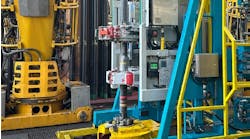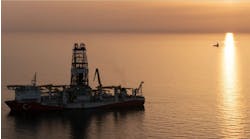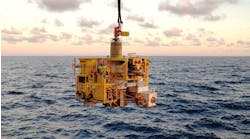Activity in the deepwater US Gulf of Mexico was quiet for the early part of this year, a little too quiet for one of the hottest activity centers in the world. In January Offshore reported that the discovery rate for the Gulf of Mexico deepwater (> 1,500 ft) had slowed to a crawl. Only one discovery had been made in the months from October 1998 to January 1999.
The exploration slowdown was blamed chiefly on the oil price. But, most believed that the US Gulf deepwater and ultra-deepwater areas were, for the most part, immune from the oil price plague as operators remained firm in carrying out deepwater plans.
However, signs began to emerge earlier this year that suggested that the deepwater and ultra-deepwater areas were being affected. The signs included continued budget cutting, project delays, and operators moving millions of dollars in equipment out of the region in lieu of better rates in other parts of the world. For example, Texaco moved its contracted Glomar Explorer ultra-deepwater drillship out of the Gulf of Mexico to West Africa.
Almost overnight, however, deepwater exploration in the US Gulf has returned in full force. Four deepwater discoveries have been made since March; another was confirmed; one development was brought onstream; and one development plan was announced. This surge of discoveries and the fact that deepwater development plans are still underway supports the view that the Gulf of Mexico is taking back its hold as the world leader in activity.
Discoveries, confirmations
Recent discoveries and confirmations announced for the US Gulf include:
- Oregeno: Shell made its third discovery in the deepwater Auger Basin. Oregeno is located in Garden Banks 559 in 3,393 ft of water. The well was drilled to a measured depth of 19,500 ft and encountered commercial quantities of hydrocarbons.
- Mad Dog: BP Amoco (64%), Spirit Energy (25%), and BHP (11%) encountered 300 net ft of hydrocarbons on the Mad Dog prospect in Green Canyon 562 in about 6,000 ft of water. The well was drilled to a total depth of 22,410 ft and is estimated to hold 100-200 million boe. Further appraisal drilling is planned for the area. The Mad Dog drilling unit encompasses two and a half blocks (Green Canyon 825, 826, and part of 782). The partners believe the gross resource potential of the entire drilling unit is 400-800 million boe.
- Magnolia: Conoco (75%) and Ocean Energy (25%) announced the Magnolia discovery in Garden Banks 783 in 4,700 ft of water. The well was drilled to 16,868 ft and encountered hydrocarbon-bearing sections of 150-200 ft net. The well was drilled with the new Deepwater Pathfinder ultra-deepwater drillship as part of Conoco's five-year, $400 million drilling program with the vessel.
- Mirage: Vastar (75%) and partner Spirit Energy 76 (25%) drilled the Mirage discovery on Mississippi Canyon 941 in 3,927 ft of water. Two wells have been drilled on the prospect. One well was drilled to a depth of 16,600 ft, and a sidetrack was drilled to 22,435 ft. No test results have been released, but further appraisal drilling is planned. The companies have said that the main pay zones on the prospect correspond to the most productive zones of the adjacent Mars and Ursa fields. The well has been temporarily abandoned.
- Llano (confirmation): EEX (30%) and partners Enterprise (30%), PanCanadian (20%), and Mobil (20%) have confirmed the Llano discovery made last year in 2,700 ft of water. The Llano No. 2 well on Garden Banks 386 was scheduled to be drilled to a depth of 25,000 ft, but was suspended at 22,000 ft due to increasing pressure. The well confirmed the presence of hydrocarbons over one mile away and approximately 2,350 ft structurally higher than the Llano No. 1 well. Due to the suspension, the well did not test all of the objectives, but it successfully delineated the eastern portion of the field. Analysis of the results is currently underway.
Production, development
One key US Gulf of Mexico field - Ursa - was brought into production recently. Shell and partners BP Amoco, Conoco, and Exxon, began oil and gas production from the Ursa TLP in 3,800 ft of water on Mississippi Canyon 809. The current daily production is 13,000 b/d of oil and 20 MMcf/d of gas. Gross ultimate recovery is estimated to be 400 million boe.
Ursa has surpassed the previous water depth production record set by Shell's Ram-Powell TLP in 3,214 ft of water. The tension-leg platform (TLP) is also the largest structure in the Gulf of Mexico, with a total deck height of 485 ft. Total project cost is about $1.45 billion.
Also, Shell plans to bring on production the Macaroni Field on Garden Banks 602 and the Angus Field on Green Canyon 113 later this year.
Recent development plans have been announced by Shell for Brutus. The field has 200 million boe in reserves and is located on Green Canyon 158 and 202. Water depths at the site are 2,750-3,300 ft. Brutus was discovered in December of 1988 and has had two wells drilled on the field since.
Shell has decided on an eight-slot TLP for the development of the field to be installed in 2,985 ft of water by mid-2001. In the third quarter of this year, eight wells will be batch set using a semisubmersible. At least one of the planned development wells for the TLP will be predrilled shortly thereafter.
Further development wells will also be drilled from a platform rig following initial production. Oil production will run via an 18-in. pipeline 26 miles to the South Timbalier 301 "B" platform where it will be connected to the Amberjack System. Gas will be transported to the Manta Ray Offshore Gathering System 24 miles away through an 18-in. pipeline. Pipeline construction will begin next year. Total cost for the project will be about $900 million including pipelines.
Brutus will be the company's fifth TLP in the Gulf of Mexico and will be based on a similar design to that of Ram-Powell and Mars. Shell also intends to use Brutus as a hub for future subsea projects, which may be developed in the area.
Production is expected to begin by late 2001 and flow at a peak rate of about 100,000 b/d of oil and 150 MMcf/d of gas.



